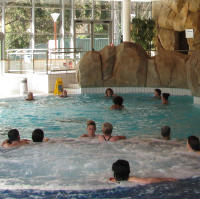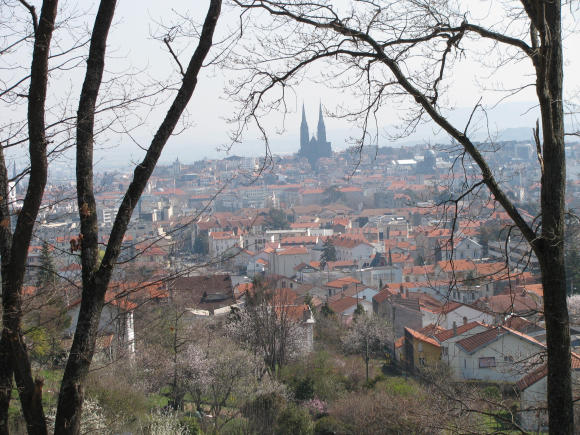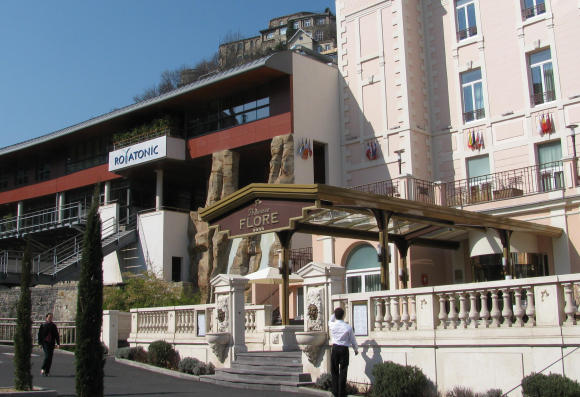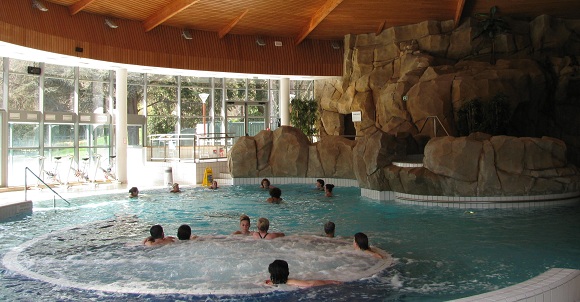
Like a doctor who mistakenly operates on your left leg when it’s the right leg that’s gone lame, my Avis scratch sheet at the Clermont-Ferrand train station claimed slight damage to the left wing of the car though some of those scratches were on the right.
I knew from experience that rental agencies in or near train stations and airports in France simply give you the keys, once you’ve signed the necessary forms, and send you on your merry way to hunt for the vehicle at the far end of the parking lot. And since one of those forms is an inevitably incorrect sheet indicating the agency’s version of pre-rental dents and scratches to your vehicle, your failure to re-inspect may come back to haunt you when you find yourself being asked to pay for someone else’s fender bender.
Having returned to the agency to correct the error, I then set off with a slightly scratched but correctly recorded compact and headed to Royat, the first hot springs/spa town on my list on this exploratory trip to Auvergne.

I assumed that Royat would be bucolically removed from the city, and my assumption had been reinforced by the fact that a tourist official had told me to give myself 30 minutes to reach Royat from the train station. She must have guessed, though, that I’d spend the first 20 minutes correcting the rental car scratch sheet though, because after only a 10-minute drive my GPS told me that I had arrived. But I didn’t appear to have arrived anywhere other than a slope on the edge of the city. It felt like being in Yonkers after leaving the Bronx, suburban yet still city.
Furthermore, my GPS, I discovered by the end of the day, would accept street names but not numbers, so it would abandon me at the start of a boulevard or avenue and leave me to rely on direct sighting to find my actual destination. My first destination, the Hotel Princesse Flore was indeed at the start of the avenue, but I went up and down the full length twice before feeling sufficiently confident behind the wheel on these narrow, winding streets to raise my eyes high enough to see “Princesse Flore” written on the side.
Timeline for hot spring towns in Auvergne
I’d come to visit this 5-star hotel and the adjacent spa and water park because they represent the latest step in the town’s economic evolution, an evolution that began nearly 200 years ago with the discovery of its hot springs.
Though not the case at Royat (aka Royat-Camalières), some hot springs in the region were already exploited during Gallo-Roman time (e.g. Le Mont Dore). Some supplied hot water and even heating to villagers in the Middle Ages (e.g. Chaudes-Aigues). And some were already attracting visitors in the 18th century (e.g. Chatel-Guyon).
For the most part, however, the development of these hot springs medical/leisure “resorts,” as we would now call them, largely occurred during the 19th century according to the following schema.
1. a trickle of visitors following the discovery of the spring (1822 at Royat);
2. the arrival of developers with a vision (1845 at Royat);
3. an increasing stream of visitors including some fashionable French or European aristocrats, who put the destination on the proverbial map (in 1862 the most notable of French aristocrats visited Royat: Emperor Napoleon III, who suffered from rheumatism, and Empress Eugenia, who suffered from his incurable philandering);
4. the construction from 1880 to 1913, the Belle Epoque period, of ever-grander hotels and villas and buildings with furnished rooms to rent;
5. a restyling, after WWI, of water towns and their installations for the evolving high-end curists (patients taking the cure), their entourage and other vacationers; at the same time, further studies were showing the medical benefits of the waters, whether through bathing, drinking and/or inhaling vapors (mostly for rheumatism at Royat);
6. an attempt to keep on a happy face after WWII despite increasing competition from beach resorts and jet vacations;
7. a fall from grace through the 1960s as thermal baths lost their luster and the state health system pays lesser fortuned visitors to come for a 3-week medical cure, and
8. an attempt since about 2000 for local government to encourage the arrival of medical curists while trying to find ways to develop other forms of tourism with or without the thermal baths themselves.
(There are no luxury resorts among the hot springs that I visit in this series, but that doesn’t mean that Auvergne can’t appeal to luxury travelers seeking rural pleasures.)

Royat, Princesse Flore, Royatonic
Royat itself was never a major spa town despite Napoleon III’s visit—the emperor showered most of his imperial thermal favors to Vichy—, but for a time it held its own. Its medically prescribed thermal facility still welcomes about 9000 “curists” per year with a prescription to take the waters for rheumatism and certain cardiovascular diseases.
The hotel across the street from Royat’s medical thermal center entered the scene at Phase 4 of the timeline above. Built in 1883, it was renovated in the 1920s, as can be seen from the Art Deco styling of the public areas, but fell into decline in the final decades of the century. It closed altogether in 1999 (another half-dozen hotels would close over the following decade), took a deep breath when it was purchased by its current owner, Isidore Fartaria, in 2001, and reopened in 2009 as Le Princesse Flore, named for the owner’s youngest daughter. It is now a 5-star hotel, which places it a couple of notches higher than any of the hotels in the Clermont-Ferrand.
As noted at Phases 6 and 7 above, the moneyed crowded increasingly turned away from hot springs such as these in the decades following WWII. Competition from more modern coastal or foreign resorts coincided with moves to include medical water therapy among those treatments to be covered partially or fully by the French public health system.
It was a double-edge sword. Medical coverage of taking the waters meant that certain thermal facilities would continue to function and perhaps flourish by attracting patients of the national health system, but it also led the well-to-do to spend their well-being funds elsewhere. After all, the latter were not about to hang out with the general and elderly population that could now enjoy (or suffer in) the same the hot springs thanks to a doctor’s prescription that meant that some or all of their expenses covered or reimbursed by the state system (le Sécu) and the rest by complementary insurance.
Several times during the course of my stay in the region I would be told that the Sécu killed the high life of the hot springs in France. While that’s somewhat true (as I’ve noted, coastal resorts and foreign resorts also played a role), the Sécu has also allowed helped these towns to survive.
But no spa town wants to live by Sécu alone. For all its positive effects on the well-being of citizens and long-term residents, doing so could a town into a socialist retirement home. (Interestingly, spa towns tend to vote rightward rather than leftward.) So in recent years Royat (pop. 4500) and other towns have sought ways of giving some economic umph to their aquatic heritage by coupling local or regional public investments with private investients.
The Princesse Flore, privately owned, and the adjacent spa and water park Royatonic, owned by the municipality, are a case in point.
As the top hotel in the immediate Clermont-Ferrand region, the Princesse Flore is primarily (at 85%, according its director) a business hotel. There’s no good reason for an upscale leisure traveler to stay here (might as well leave the urban environment altogether) unless transiting as a family through Clermont-Ferrand on an overnight. However, if I were a business traveler who’d just spent the day at one of those French meetings that end with everyone promising to think about the situation some more and to call each other in another week or two, or three or four because vacations are coming up, I wouldn’t mind coming home to this 43-room hotel. In addition to the visible comfort of the rooms and suites, guests have free access to the watery playground of Royatonic next door and can purchase some spa treatments there.

I did not stay the night since I had a chateau-hotel in the country to look forward to that evening. But I took the time to relax for 15 minutes on a hydro-massage bed (Hydro-Jet) in Royatonic’s peaceable Sanhoa-branded spa treatment area and then made the rounds of steam, baths (cold, warm, hot, scented) and basins of its water park. At Royatonic, the water springs from its source at 86F (30C) and his heated several degrees for the indoor pool and several degrees more for the outdoor pool, which is open year-round.
Royatonic is a public project (with plans for expansion), publicly funded and operated, that, according to its director, turns a profit. How it’s public investment and operation is actually calculated with respect to that profit I leave to French journalists to investigate, but the figure that I was given of 165,000 visitors for last year is indeed significant.
Royatonic is certainly a nice place for locals and for business travelers to gather and relax—except when there’s an underwater spin class going on and the music is pumped up in contradiction of the sign asking visitors to respect the calm.
The group was cycling to the tunes from “Grease”: “Grease lightning, go grease lightening…,” “Tell me more, tell me more, did you get very far…”
So much for relaxation.
Anyway, I’d come for research rather than zenitude, and I had a lunch appointment at Chatel-Guyon, the next spa town on my list.
So I plugged Chatel-Guyon into the GPS, with Anywhere for a street name, and drove into the hills.
© 2012, Gary Lee Kraut
Hotel Princesse Flore, 5 place Allard, 63130 Royat. Tel. 04 73 35 63 63. Princesse Flore is the first French member of Best Western’s Premier association of hotels.
Royatonic and Spa SanHoa, 5 avenue Auguste Rouzard 63130 Royat. Tel. 04 73 29 58 90.
Return to Part I: From Paris to Clermont-Ferrand by clicking here.
Go to: Part III: Chatel-Guyon.
Part IV: Chateau La Caniere, a luxury hotel.
Part V: Mont Dore, Saint Nectaire, Chaudes-Aigues and Yu.


